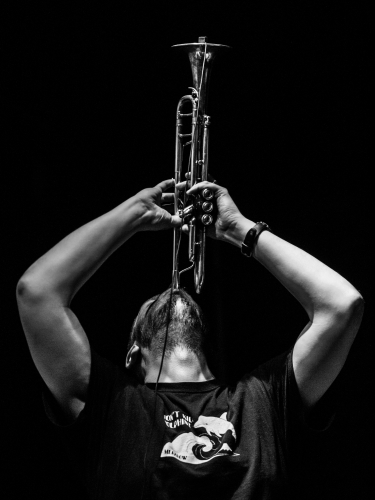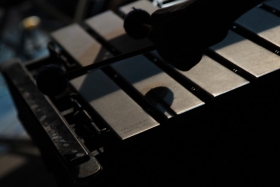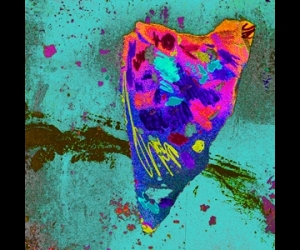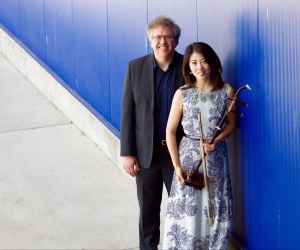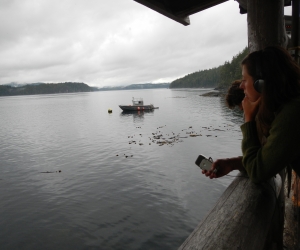Jump into an early version of Nate Wooley’s Seven Storey Mountain, and you land in dark and turbulent, almost infernal terrain. Sounds are dense and blur into one another: trumpet amplified to distortion levels; prerecorded tape of unidentifiable noises; dense, rapid drumming of indecipherable rhythms. Later versions add more orderly elements: passages of stable pitch and rhythm, moments of clarity that deepen the mystery.
When Thomas Merton chronicled the spiritual struggles that led him to abandon the life of an urbane intellectual for that of a monk, he borrowed for his book’s title the metaphor Dante had used for purgatory: the seven storey mountain. Merton’s autobiography is a collocation of impenetrable mass and upward movement, of culture and technology, and the found world of nature in its most intractable form. Nate Wooley’s reborrowing of the phrase as the title for a musical work inspired by images of struggle, ecstasy, and failure that are found in the hermetic literature is every bit as apt.
Since Wooley first performed Seven Storey Mountain at New York’s Festival of New Trumpet Music in 2007, there have been four distinct versions, each performance a new expedition, with both subtle and wholesale changes in elements and with additional components. Wooley has been performing new versions at two-year intervals at Brooklyn’s Issue Project Room. Each version has been assiduously documented. The first two versions appeared on single CDs from the Important label. In October 2013 Wooley released a two-CD set of the latest versions to launch his own Pleasure of the Text label. Over six years, the instrumentation has expanded from three to thirteen players, and the recorded tape and cued improvisation have come to interact with fully scored elements.
To approach Wooley’s work, you need to consider his reading list. He took inspiration from Christian mysticism and esoteric Buddhism and began to apply it—literally reading texts through his trumpet and combining them with the sounds of his house. He even coined a word for that special sense of ecstasy as ideology and technique: ecstaticism. “I’m not sure where I got it from, but it somehow works in my mind,” he says, musing on his coinage. “I use it to describe that certain feeling you get from hearing a group of musicians completely engaged in what they’re doing, whether it’s music openly trying to reach a feeling of transcendence—like religious drone music, free jazz, noise—or is simply a finely tuned string quartet. You know that feeling—where you’re drifting in and out of being conscious, that you’re hearing something really special and a part of a community, a special subset, a moment in time, a place, something shared. It has nothing to do with religion or spirituality in a defined sense, but just a certain inarticulate feeling.”
That inquiry into texts and the developing concept of the piece hinge on the dichotomy between the imagination of the ecstatic and the press of the quotidian world and simple human failure. “The original inspiration was a certain idea of embracing human foibles and failure and presenting them as a part of your work,” Wooley continues. “That’s been an important concept to me with most of my composition in the past five years—taking the imperfections and missteps that make us human and amplifying them, hopefully to present a complete picture of the person, in this case me, to the people consuming the work.”
For Wooley, it meant finding where musical risk might lie, a path at once inward and outward. “I knew that I wanted to deal with concepts of drone and directed improvisation, along with a sense of nonreligious ecstaticism, and that I wanted to do it with people who would not necessarily work together otherwise. This was a departure from what I had been doing at the time and contained elements of risk, but at the same time, it was absolutely what I was hearing in my head and what I believed in musically. So, with the philosophical inspiration and the musical goals, all the pieces started coming together to push me into undertaking the project.”
Merton’s The Seven Storey Mountain was just one philosophical influence. Wooley had been reading texts by the mystics of different religions, following Aldous Huxley’s reading list for his 1945 book The Perennial Philosophy, and picking up whatever he could find: Sri Aurobindo, Thomas of Aquinas, St. John of the Cross, the Evans-Wentz books on Yoga (Tibetan Yoga and Secret Doctrines, The Tibetan Book of the Dead, etc.). “Ultimately, I had more of an interest in the people behind the writing than their writings as a practice toward self-actualization or spiritual awakening, probably because I was entering into their study through the lens of Huxley and his search for broad connections between multiple religions.
“There tends to be a feeling [in those books] of the deification of the writer,” Wooley explains. “In most cases, these people are saints, or some equivalent, and are presented as perfected beings. Writers like Merton, St. John of the Cross, and especially St. Augustine, attracted me though, because of their willingness to be open and honest about their humanity. It made me realize that recording is a medium that allows for a similar range of presentation of the artist. I don’t want to compare myself to any of these writers, but the broad idea of how Merton and others opened themselves up as raw, flawed humans striving after a goal, with very little filter, was attractive to me.”
There began a process of search, trying to find materials that would begin to express this surfacing idea. But musically, Wooley recalls, he was all over the place at the time. “The only thing certain was that I needed to stay away from dogma and hero worship, which are two things I’m prone to let paralyze me. A lot of people can work within a certain set of tight parameters or historical context and create beautiful new things, but I’m not that person. It’s only in the negative context that I can do anything I feel is successful, so I have to work in that way to be happy.”
Wooley began with what is an essential element of each version: a tape recording magnifying the noises of his home. “In a way, the tape piece is the score for each work. I make each tape first, and then construct the acoustic scores around it. It provides structure and gives cues to the players that let them know when to make moves in the material. The original tape was made completely from close miking the machines in my house, especially a window-unit air conditioner and our refrigerator. I cut the tapes to give them a sense of a continuous pitch and then created a skeletal structure of forty minutes or so that the original trio [with English drummer Paul Lytton and David Grubbs, best known as a guitarist, playing harmonium] could work over.”
There have always been three compositional elements, Wooley explains, which all exist in an abstract form on tape, but are also considered in the score: drone, velocity, and the idea of voice. In the original score, it was pretty simple: David Grubbs was the drone, Paul Lytton the velocity, and Wooley the voice. “I needed to structure the score to work with each of their comfort levels and strengths,” he recalls. “That first version was very simple. There were aural cues for Paul to come in and out, and a basic dynamic shape to direct his energy. One of David’s many strengths is his ability to patiently work a small amount of material for a long period of time, so he was given a couple of aural cues, as well as a small amount of cellular harmonic material to work through on harmonium. I had a series of texts that I intoned through the trumpet, a lot of things from religious texts, Herman Melville (the sermon from Moby Dick), some more apocalyptic writing, which I let myself obfuscate by concentrating on specific phonetic sounds as opposed to speaking verbatim.”
The power of the first performance is undeniable. It’s as if Wooley has found a way to focus all his concerns about human failure and his quest for ecstatic meaning into a performance hinged between composition and free improvisation, the wall of ever-evolving noise blurring the usually static element of drone with the dynamic element of percussion. Armed with the knowledge of Wooley’s sources, questions emerge: Is it a closely miked air conditioner or an amplified trumpet? Wooley moves the notion of musical risk into a soundscape of fear, his voice passing unintelligible words through the tubing of his trumpet. The sheer power of the materials used in his Seven Storey Mountain, and of the piece of music itself, have drawn Wooley to it repeatedly, making it an autobiographical and musical index of his life.
In the process of revisiting the work, the three compositional elements have remained the same, as has the idea of the tape. But with each version, Wooley has tweaked the scores to reflect changes in personnel and performance spaces. “For Seven Storey Mountain II (in 2009), it was a trio again, but with C. Spencer Yeh on violin and Chris Corsano on drums. The score was similar to the first, but Chris and Spencer approach the idea of velocity and drone in different ways, and so the tape became more aggressive, to support that. It’s the most improvised of the four versions—which fit in more with the trio’s aesthetic.”
In 2011, Wooley’s residency at Issue Project Room gave him access to the large array of speakers there at the time. The piece was performed with both earlier trios (Grubbs now playing guitar), plus two vibraphones. “By adding vibraphonists Matt Moran and Chris Dingman, it was necessary to introduce more fixed parts, as I didn’t want it to just become a free-for-all,” Wooley recalls. “So, this time, besides the scoring I had done for previous versions, I added notated material for the vibes that they could cycle at different paces, using the tradition of bell-ringing as a model. The tape in this piece became more skeletal, as well, to give room for the added instrumentation.” It’s a supreme validation of Wooley’s exploratory aesthetic processes that elements take on a life of their own, intentions unravelling into new dimensions and perhaps ravelling back again. The addition of the vibraphones may be a prime example, now heard on Seven Storey Mountain III, their glittering, shimmering metallic waves suggesting the resonant calm of temple bells. “The vibes were added to give the piece a different character. The first two versions are about raw emotion: confusion, anger, fear, aggression. By the third piece, I personally had come to a place where I felt more serene and accepting of my life, and wanted to give the work that same feeling. The vibes started pointing the way to that, although in the room the overtones clashing between the two instruments due to their very slight pitch differences were the harshest and most disconcerting part of the piece. Unfortunately, the way it was recorded doesn’t highlight that.”
The sense of ritual that the vibraphones emphasized has become ever more explicit in the fourth version, performed at the Issue Project Room in June 2013, with the first addition of fully scored segments. Scheduling conflicts saw Lytton replaced by drummer Ryan Sawyer, and Grubbs replaced by Ben Vida on electronics; Corsano, Yeh, Moran, and Dingman all returned. Then Wooley took the radical step of adding the three trumpets and three trombones of the TILT Brass Sextet. “Everyone’s scoring remained the same, at least how they were working—that is, improvised, aleatoric pitched elements, et cetera—but with the sextet, I added the first completely notated writing. This meant setting up a feeling of time in the tape that Chris McIntyre, TILT’s director, could cue off of to conduct the sextet as it floated above the tape and the rest of the musicians. Because I now had thirteen players, I had to think more about orchestration, which added to the complexity of entrances and exits of material.”
With four versions of Seven Storey Mountain behind him, Wooley reflects on the shifting form and value and materials of the work, from the transformation of the original tape to the addition of the sextet: “The structure of the tape has always changed through the process of stripping the previous tape to a skeletal set of sounds, which I then build the new tape structure over. As each generation of the tape has been created, the previous has been stripped to a different set of sounds, so a sonic thread runs through the first four pieces, but there is nothing in the fourth version of the tape that was found in the first.”
Yet the basic roles of drone, velocity, and voice have not changed throughout. He continues: “It’s become a bit like a game of telephone, as I write each new version. The feeling of velocity in the original came from a very specific place tied to Paul Lytton’s playing and personality. That changed when Chris Corsano played, as his idea of velocity is much different. By the time we got to the fourth piece, the drums are taking on roles of velocity and drone, and the tape is also using prerecorded drums to create that velocity as well.”
The addition of the brass sextet presented a similar situation. With the brass, Wooley could write for a different feeling of voice, by having the sextet play large voicings inspired by Wagner and some of Messiaen’s orchestral work. “It’s a different kind of voice, less personal and raw, but collective and strong,” he points out. “Since the beginning, I’ve understood this is not something you can manufacture. I guess that’s what I mean about being unable to realize it. I can put people in place and put in their hands music that I think will allow them to feel comfortably part of that community. But I can’t create a situation that will necessarily produce the ecstatic result. We got pretty close in version four. It’s not actually an achievable goal to me. I would rather see how close we can come without realizing it, than be able to reproduce the feeling in a mechanical way.”
Wooley’s Seven Storey Mountain is a profound work of both ascent and interiority—like a building masked by and secreted within nature—not only suggesting the earth as divine text, but also as architecture, like the fundamental processes of music discernible in a reed or the division of a string. That sense of an altered state that conditions all of life is there in the tapes of household sounds, and it’s especially evident in the way his special investigation of music and language plays a part in each piece.
The work’s potential for symbolic value becomes more apparent with each new iteration. It’s part of Wooley’s accomplishment that the work has become larger without becoming significantly longer. Version four begins like a broom, air passing through a horn or an electronic hum, and eventually clarifies as brushes on drums, suggesting the sweeping of a temple. C. Spencer Yeh’s biannual solo, ever more frenetic, is a mad infernal scratching to clear an ever-accumulating veil. TILT Brass Sextet adds a stately sense of permanence, a new fixity to the ritual. By the end, violin, electronics, and percussion experience an anarchic merging, with a kind of absence at the centre of the taped sounds, while melody passes from brass to an electronic wail that just might be pedal-fuelled violin.
With repeated listenings, Seven Storey Mountain takes on an inevitability and a greater power, its message both exposed and concealed. Stay tuned.
Companion article on Nate Wooley's musical identity and explorations in extended techniques available for your reading pleasure ONLY in the PRINT EDITION of Musicworks 118 (Spring 2014).
FYI: In 2013, Nate Wooley launched his Pleasure of the Text Records, with a double-disc recording of Seven Storey Mountain III and IV (POTTR1301). Wooley performs Seven Storey Mountain V with a large ensemble of musicians, including TILT Brass Octet, on Saturday May 21, 3 p.m., at the 2017
Festival International de Musique Actuelle de Victoriaville.
UPDATE 2020-10-22: Seven Storey Mountain VI is released on Kris Davis' s Pyroclastic Records.
Audio: A Short Study for
Seven Storey Mountain IV, Live. Composed by Nate Wooley. Performed by Nate Wooley (trumpet) and TILT Brass Sextet.
Images: Nate Wooley (top); vibraphone.
Photos by: (top)
Peter Gannushkin and (homepage and vibraphone) Bradley Buehring, courtesy of
Issue Project Room.
